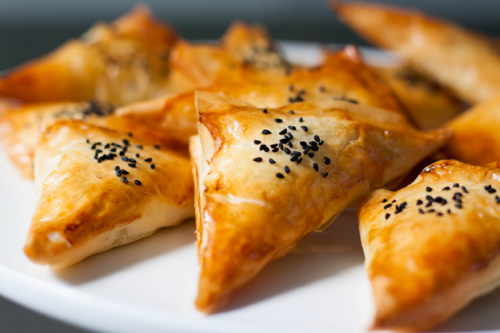Cheese and Chard Triangles
 Monday, April 27, 2015 at 10:25PM
Monday, April 27, 2015 at 10:25PM 
On Friday I did my second demo at the Natoora shop in Turnham Green. I made loquat chutney, which we served with pappadums and naan bread, and these cheese and chard triangles. They were both very well received; a couple of people even asked if they could buy some, nice!
I deliberated a while over what to call these. In Australia I would have called them ‘pasties’ without a doubt, but in the UK that implies something Cornish and stodgy with a short and lardy pastry. Delicious, but not quite what I mean.
In Australia spinach and cheese pasties are almost as ubiquitous as meat pies. They are usually made with puff pastry and stuffed with spinach and cheddar or ricotta. My cheese and chard triangles are more like Turkish börek, since I use feta, as well as ricotta, and add dill and mint to the mix. I also tend to use filo pastry, though ready-made puff is a great cheat if you are short on time.
The main difference is that most recipes for börek use a mix of milk or yogurt, egg and butter to brush the layers of filo pastry, so the pastry layers tend to be soft and doughy. I prefer my pastry golden and crispy all the way through so I just use butter.
The instructions here are for small triangles (approx. 25-30). They are great as snacks or canapés. You can adjust the size of the pastry strips to make large ones for a more substantial meal. I sometimes serve with cacik or labneh to dip, though they are delicious on their own.

Ingredients
500g Swiss chard, stalks and central veins removed
250g ricotta
200g feta, crumbled
Small bunch dill, finely chopped
Handful mint leaves, finely chopped
Salt and freshly ground black pepper, to taste
1 packet filo pastry (approx. 250g)
50g butter, melted
1 egg, whisked
Handful sesame or nigella seeds (optional)
Method
Grease two large baking trays and preheat the oven to 190°C
Cook the chard in a large saucepan of salted boiling water for 5 minutes or until tender. Drain and place in muslin or a clean tea towel and ring out as much moisture as possible. Chop the chard.
Put the chard in a bowl along with the ricotta, feta, dill and mint. Mix well and season with salt and pepper, to taste.
Place a sheet of filo pastry on a dry, flat surface and slice into 3 strips approximately 10cm wide. Keep the rest of the pastry under a lightly damp cloth to keep it from drying out.
Take one strip and brush with butter. Place 1 tablespoon of the cheese and chard mixture at one end of the pastry strip. Fold the end of the strip over the filling diagonally to form a triangle. Continue folding the strip in triangles till the strip ends and you have a stuffed pastry triangle. Place on a baking tray. Brush the top with egg and sprinkle with sesame or nigella seeds, if using.
Repeat the process until you have used all the pastry. You can freeze any leftover filling or triangles.
Bake for 10 minutes or until golden brown. Serve hot.


Reader Comments (3)
!YUM YUM YUM!
I think the addition of feta is key - I often find the ones you buy in shops here (or heaven forbid - frozen!) are always bland because they just use ricotta and so lack flavour.
Your's have always been my favourite ;P
I'm always trying to think of new things to serve as canapes. These sound perfect !
Hi Cha, WOW what an honour! I know they are one of your favourite things. I totally agree re. ricotta!
Hi Ma, yes, they are a great canape. Big ones are also nice for tea with some salad. :-)